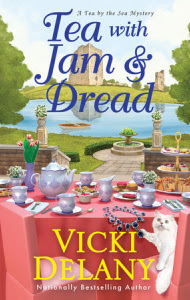by Sheila Connolly
Made you look, didn’t I?
But this blog is written by mystery writers who like to cook. And eat. We don’t do smut.
My dirty books are the cookbooks I love best. You know, the ones that fall open to your favorite recipe automatically. And when you look at that recipe, it’s hard to read because there are years of grease spatters and chocolate blobs on the page—but it doesn’t matter because you could probably make the recipe in your sleep anyway.

I own maybe fifty cookbooks, which I started collecting in my senior year in college (I lived in a dorm but we had “kitchenettes”—and we actually cooked a full Thanksgiving dinner there one year). The very first cookbook I ever bought was a cheap paperback edition of
The Joy of Cooking, just for the basics. The second, a graduation present to myself, was Julia Child’s
Mastering the Art of French Cooking—and I still have it.
I surveyed my cookbook collection, and it was obvious which ones have received the most use over the (mumble, mumble) years I’ve been cooking:
--the aforesaid Julia Child (and I now own not one but two back-up copies, in case I ever decide the original is too far gone to use)
--my mother’s
Boston Cooking-School Cook Book (aka “Fannie Farmer,” 1949 edition, so she must have acquired it shortly after she married)

--
British and Irish Cooking (Around the World Library, 1974)

--
Cookies and Candies (Better Homes and Gardens, 5th ed. 1966), which I think was the third cookbook I bought (I paid $1.95 for it—the tag is still on the cover).
These are the cookbooks I have gone back to time and time again. “Julia” is my bible, the go-to book for every meal with guests. The dirtiest page? Right in the middle: Boeuf a la Catalane, which is almost translucent with grease, and on the next page, Daube de Boeuf. I’ve been making these from Day One, and even my husband has adopted them.

I treasure the Fannie Farmer because it includes annotations from my mother and my sister, made over decades of us (my grandmother had her own copy, which I also kept). The spine fell apart years ago. Funny, but it looks like the section that got the heaviest use was…desserts. It makes entertaining reading, as it is filled with dishes that no one makes any more. There’s even a section labeled “Fish in Second-Day Dishes.” Huh?
I forget why I bought the
British and Irish Cooking book, but it has the best lamb stew recipe I’ve ever had, and we make Toad in the Hole regularly, as well as Bubble and Squeak. (Gotta love the names!)

And finally, my much-loved
Cookies and Candies. I think I have more cookie cookbooks that any other kind, and I keep buying them, looking for something new and different. But I always come back to my first love. It falls open to the page for Paul Bunyan Sugar Cookies, and I notice that there is an accumulation of flour in the groove there. I’ll give you the recipe—with my modifications (I’m not sure what copyright issues may apply, but I have changed this recipe over the last thirty-something years of use). It’s the recipe I used when I sent my then-fiance a box of pink hearts, and when I entertained my daughter and her ballet buddies after school, and of course for many years of Christmas cookies.
Foolproof Sugar Cookies
¾ cup butter
¾ cup solid shortening
2 eggs
1 Tblsp. vanilla
2 Tblsp. whole milk
4 cups sifted all-purpose flour
3 tsp. baking powder
½ tsp. salt
Sift together the flour, baking powder and salt. Cream the butter, shortening, sugar, eggs and vanilla until light and fluffy. Stir in the milk. Add the sifted dry ingredients and blend well. Wrap the dough in plastic wrap or put in a plastic bag and refrigerate for one hour (this is important—it makes the dough much easier to handle when you roll it out).
Roll the chilled dough to ¼-inch thickness. Cut with your favorite cookie cutters. If you wish, you may sprinkle the tops with granulated sugar, or any other decorative sprinkles you like. Place the cookies about 1 inch apart on an ungreased cookie sheet. (You can combine the scraps and reroll the dough for more cookies.)
Bake at 375 degrees for about 10 minutes, or until the edges are lightly browned (don’t
overcook!). Remove from the pan and cool.
These keep well in a closed container (I think the flavor actually improves after a couple of days—if they last that long!) Don’t ask me how many this makes—it’s a bunch, probably between three and four dozen, depending on how big you cut them.
![RileyAdamsFoodBlogPostpic_thumb_thumb[3] RileyAdamsFoodBlogPostpic_thumb_thumb[3]](http://lh4.ggpht.com/_v68WnMKHlKQ/TKNwm28hQtI/AAAAAAAAB3E/TmCBM6nswww/RileyAdamsFoodBlogPostpic_thumb_thumb%5B3%5D_thumb%5B1%5D.jpg?imgmax=800)
 And I’ve got a strong desire to eat orange food. :)
And I’ve got a strong desire to eat orange food. :)







































 - 2 teaspoons Worcestershire sauce
- 2 teaspoons Worcestershire sauce














































